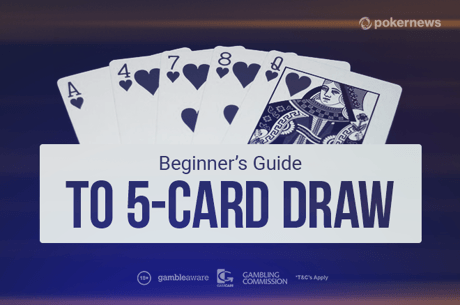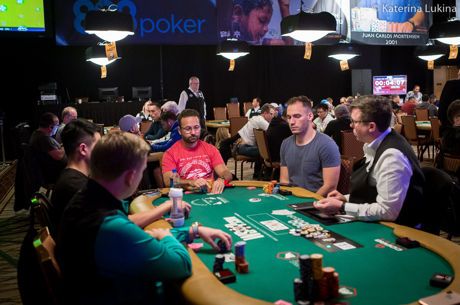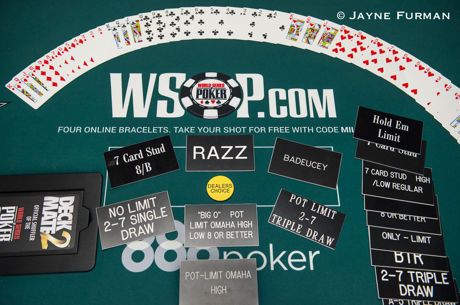The Schedule and Strategy: A Look at Mixed Games at the 2015 WSOP

Last week the 2015 World Series of Poker schedule was released, with the 68 bracelet events covering the usual wide variety of games and buy-ins with several new additions as well. There are many opportunities for lovers of “mixed games” or games other than no-limit hold’em to play their favorites again, too, one of the distinguishing characteristics of the WSOP as a tournament series.
Not long ago, poker player and writer Ken Lo published a valuable guide to non-NLHE games titled A Poker Player’s Guide to Mixed Games. The book includes thorough chapters offering strategy advice for many different variants, covering limit hold’em, Omaha hi/lo, razz, seven-card stud, seven-card stud hi/lo, 2-7 triple draw, pot-limit Omaha, Badugi, Badeucy, Razzdugi, 2-7 single draw, and Crazy Pineapple hi/lo.
Like many of us, Ken has been spending the last few days looking over the 2015 WSOP schedule. Given his knowledge of many different poker variants — including his experience playing at the WSOP — we thought we’d ask him his thoughts about the new schedule, as well as to share some strategy advice for playing mixed games.
PokerNews: What are your general impressions of the 2015 WSOP schedule as far as mixed games are concerned?
Ken Lo: To start, it appears the two-tiered track system established last year has been left intact for 2015. This means there will once again be a $1,500 event as well as a Championship $10,000 event in each of 10 featured non-no limit hold’em disciplines. The lower buy-in option has made these events more accessible to amateur players, which I believe is an important step to growing and maintaining interest in these games, and in poker generally.
Second, the starting stacks for all $1,500 events have increased, and the structures substantially improved with the inclusion of additional (or repeated) intermediate blind levels. I think all players will welcome these changes, regardless of skill level.
Finally, the $1,500 Dealer’s Choice event, which garnered rave reviews last year, has returned. It was such a fan favorite that I wasn’t at all surprised to hear that a new $10,000 Dealer’s Choice Championship will make its debut in 2015. We’ll have a chance to see the best poker players in the world show their mastery of 19 different variants of poker. It should be very exciting!
All in all, I think the WSOP organizers have done an outstanding job with this year’s schedule.
What mixed games that are not on the current schedule do you think could realistically be added in the near future?
If the last two years are any indication, it seems that new variants would likely be first introduced through the Dealer’s Choice event. Growth to a set of 20 or 24 games in this mix seems quite plausible.
Since the proportion of stud games in the Dealer’s Choice mix is relatively low compared to the number of flop and draw games, I would expect that at least one additional stud game will be added to the mix in future years — perhaps a contemporary variant such as Razzdugi or an old classic like five-card stud. There have also been suggestions of adding a “pineapple” variant (e.g., Crazy Pineapple hi/lo), or an additional Omaha variant such as Courchevel, which apparently has a large European following.
Of all these variants, I think some of the more popular games or combinations, such as Big-O, or a Badugi/Badeucy/Badacey mix, could attract a decent field if offered as stand-alone events.
Do you think the $50K Poker Players Championship (PPC) which now follows the 10-game mix format (the H.O.R.S.E. games, 2-7 NL Draw, 2-7 Triple Draw, Badugi, NLHE, and PLO) is the best test of poker skill, or would you suggest any other format?
A multi-variant format is going to be a better test of overall poker skill than a pure no-limit hold’em tournament. Diversity is key. I like the transition to 10 games since the draw games are now more fairly represented. Draw games make up roughly one-third of this mix whereas there was only one draw game in the previous 8-game mix.
WSOP Tournament Director Jack Effel recently suggested that the format change of the PPC to a 10-game mix in 2015 may simply be a stepping stone to ultimately offering the PPC in a Dealer’s Choice format. I think making such a change for 2016 would be in line with popular sentiment, and would represent a bold step toward modernizing this event.
@AllenKessler @EricCrain @WSOP adding more games to $50K get us closer to what most players (IMO) would like to see in PPC - Dealers Choice.
— Jack Effel (@WSOPTD)
Let’s talk a little about strategy for mixed games. What’s the most common mistake you see players make when playing mixed games? Is it erroneously applying no-limit hold’em strategies when not warranted?

I occasionally encounter opponents who are not familiar with even the basics of the games they are playing. It is obvious that knowledge of the hand ranking systems used is very important. That said, simply learning the rules of a new game or what constitutes a winning hand is not enough. In my view, the biggest challenge faced by players new to mixed games is becoming familiar enough with the different variants so they can appreciate what constitutes a “good” and “bad” hand in different situations.
For example, hold’em players often regard sets and straights made on the flop as very strong holdings. However, in Omaha variants, it is possible to flop the nuts and still be an underdog to win. As a further example, it is also common to see NLHE players overvalue high hands in split-pot games where one-half of the pot is awarded to the best high hand while the other is awarded to the best qualifying low hand. These players are often overaggressive with their made high hands in situations where they ought to be playing more cautiously.
Although it can certainly be fun to “wing it,” it is difficult to be good at something unless you put work into it. Consider engaging in some amount of study, perhaps through reading, watching videos, or discussing hands and strategy with more experienced players. I think combining study and practice is the most effective way for aspiring mixed game players to learn what constitutes “good” or “bad” hands in various situations.
Say I’m playing one of the Dealer’s Choice events this summer and a game is called with which I have absolutely zero experience or specific strategic knowledge. Being well acquainted with such a wide variety of games, is there some general advice you could give me to follow in such a spot?
If you encounter a game that is unfamiliar, it becomes that much more important to select your starting hands carefully. In these situations, usually “tight is right.” Even with little to no experience, if you know what the goal of the game is (e.g., usually you’re trying to make the highest possible hand, the lowest possible hand, or both), and you understand the system used to rank hands, you can usually figure out what is likely to constitute a good starting hand. Sticking to the strongest of starting hands at the outset may be a conservative approach, but it will have the benefit of making your decisions on future streets easier, more often.
Furthermore, when faced with a new game I usually think about similar games that I am familiar with, and try to work out what strategic adjustments might be needed based on the differences. In this regard, here are a few general points to keep in mind (some of these may be somewhat obvious once you’ve put your mind to them):
In flop games, the more cards each player is dealt, the stronger the hands that can be made.
You may encounter variants where 2, 3, 4, 5, or possibly even 6 hole cards are dealt to each player. The average strength of hands that are flopped and ultimately shown down will be higher as the number of hole cards increases, so you will need to adjust your expectations of what is considered a strong hand. Even when you manage to flop the best hand among your opponents, the greater the number of cards each player holds, the more vulnerable your hand will be, particularly when your hand has little chance of further improving and especially when the pot is multi-way.
The number of hole cards also impacts starting hand selection. For example, a pair of aces is a great starting hand when you are dealt only two hole cards; however, the same pair of aces with a few random cards in a starting hand becomes much less valuable. The strongest starting hands will typically consist of cards that all coordinate well with one another, increasing the chances of flopping strong hands and draws.
In stud games, it is very difficult for a marginal starting hand to improve quickly to a strong hand.
In hold’em or Omaha variants, three-fifths of the board will be revealed immediately after the opening betting round. By contrast, you will often need to endure multiple rounds of betting in a stud game before getting a sense of whether or not your hand has improved to one worthy of being shown down. Therefore, until you gain more experience, consider sticking with starting hands where all three cards can potentially contribute to a strong five-card hand.
In draw games, be aware that the number of draws has a significant impact on the strength of hands that will ultimately be shown down.
In particular, stronger hands will be made when players are given three chances to exchange cards (as is the case for “Triple Draw” variants) rather than just one. For example, while a 10-high hand in 2-7 Triple Draw is often considered a marginal hand, it represents a much stronger hand in the game of 2-7 Single Draw.
As a further example, where three draws available, it is reasonable to expect to make excellent hands when starting with two or three good cards (from a five-card hand) and discarding the rest on the first draw. However, making a strong hand after discarding two or more cards is much more difficult when only one draw is available.
In split-pot games, hands that could allow you to win both halves of the pot are generally preferable to “one-way” hands.
In “split-pot” games, two different players with different hands can each potentially win one-half of the pot. If you face a single opponent in a given hand, and you hold a hand that can only win one-half of the pot at best, you will typically be playing to simply get your own bets back. On the other hand, a holding that can potentially win both halves of the pot — a hand with which you can “scoop” — is much more profitable in these situations.
Certainly, if the pot is multi-way, it can still be profitable to play hands that are expected to win only one-half of the pot since the additional opponents will help to build a bigger, total pot. However, your “one-way” hand will need to be that much stronger since there will be more opponents to beat in order to win a portion of the pot.
Much thanks to Ken Lo for taking the time. To learn more about his book, A Poker Players's Guide to Mixed Games, including ordering information, click here.
Get all the latest PokerNews updates on your social media outlets. Follow us on Twitter and find us on both Facebook and Google+!









